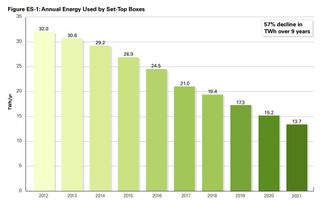Set-Top Energy Use Cut by More Than Half in Past Decade: Report
Audit released of ongoing voluntary industry energy-efficiency agreements

The cable and telco broadband and technology industries, working together, have cut set-top box energy use by 57% since a voluntary energy-efficiency effort was launched almost a decade ago. In 2021 alone, that saved consumers $2.5 billion on their energy bills.
Those findings come from an annual report from independent auditor D+R International, a report was required as part of the voluntary agreement.
It hasn't hurt that the number of deployed set-top boxes has decreased significantly, down nearly one-third since 2012. The overall decrease in boxes is combined with more energy-efficient set-tops and an increase in purchases of non-DVR internet protocol (IP) boxes that consume far less energy, the report pointed out.

Then there is the cord-cutting that has reduced the number of U.S. TV homes with a set-top from 58% of those homes as recently as 2016 to only 37% in 2021.
In 2012, NCTA–The Internet & Television Association, the Consumer Technology Association and CableLabs signed the Agreement for Ongoing Improvement to the Energy Efficiency of Set-Top Boxes, with other signatories that accounted for 95% of the traditional pay TV market in 2021, according to NCTA.
Among the companies that struck voluntary agreements are Comcast, Charter Communications, Cox Communications and DirecTV and Dish Network.
There will be more reports to come.
Multichannel Newsletter
The smarter way to stay on top of the multichannel video marketplace. Sign up below.
Last year, the signatories extended the agreement through 2025, with more rigorous energy-savings targets and the goal of cutting set-top energy use by two-thirds, with 86% of that reduction goal already reached by the end of 2021, the report concluded. ▪️
Contributing editor John Eggerton has been an editor and/or writer on media regulation, legislation and policy for over four decades, including covering the FCC, FTC, Congress, the major media trade associations, and the federal courts. In addition to Multichannel News and Broadcasting + Cable, his work has appeared in Radio World, TV Technology, TV Fax, This Week in Consumer Electronics, Variety and the Encyclopedia Britannica.










